Configuring a Beeline router. A step-by-step guide to connect a Beeline wi-fi router. Beeline routers Buy mobile router beeline 4g
Beeline is one of the most popular internet providers, even in the most remote corners of Russia. The company provides access to mobile or home internet. In this regard, many people use a Wi-Fi router to save money and convenience.
It can be purchased at many points of sale. Configuring a Beeline router- the task is not difficult if you know the key points and features of the connection.
The process does not require special knowledge of computer technology, you can figure it out on your own. And for this it is not at all necessary to call the master and pay a considerable amount. The device installation and connection scheme is almost the same for different models of wi-fi routers: DIR 300, ASUS, TP-Link, Zyxel and others.
General setup procedure
- If the router is just purchased, you need to unpack it, connect the power adapter.
- Choose a place where the equipment will be installed.
- Connect the Internet via cable or Wi-Fi.
- Connect the device required for configuration: laptop or computer.
- Connect the router to the power grid.
- Configure the router by going to the address written at the bottom of the equipment in the browser. The user name, password are also indicated there.
- Configure the Internet (later in the article).
- Configure Wi-Fi settings. Change password and name (further in the list).
How to set up a Beeline ASUS router?
Connection diagram:
- Write the parameters: login, password specified for ASUS: admin / admin (for RT-N12 model).
- Specify the type of connection L2TP or L2T + Dynamic IP (if any).
- Fill in the columns: hostname and PPTP / L2TP, specifying the following address: tp.internet.beeline.ru.
- Check if the router is working properly: go to the Internet and open any website.
In order for Wi-Fi and the Internet to work properly, you need to remove the type of connection that was used before it before configuring it.
Wi-fi startup diagram for ASUS RT-N12
- In the SSID, specify a name that can be taken at the discretion of the user himself. To eliminate the likelihood of a failure with the subsequent introduction of a password on other devices, it is advisable to enter reliable characters using English letters, with lower and upper case letters. Save password.
- Click on the "Save" button.
If everything is done correctly, the wi-fi is completely set to work.
On the back panel of the device there are 4 holes for USB sticks, and 1 for Internet beeline. You need to insert a wire from the Beeline Internet into the blue port. The second connector must be connected to the wire on the PC. The router is configured from it. Then pull out the antennas and connect the router itself to the network.
Before starting the installation process, it is advisable to check the connection type on the PC. That is, the IPv4 properties should indicate automatic connection to obtain the IP address and DNS server. This is a common cause of Internet connectivity problems.
Connection diagram:
- Launch a browser, enter: 192.168.1.1
- Write the parameters: login, password specified for tp-link: admin / admin (for WR-841ND model).
- Select the WAN or Internet section.
- MTU - 1460 (for the Beeline operator).
- Print the username (Beeline login) and the password given by the provider.
- Fill in the columns: hostname and PPTP / L2TP, specifying the following address tp.internet.beeline.ru.
- Check if the router is working properly: go to the Internet and open any website
You cannot connect the Internet to Beeline yourself during the connection process and after it. This is done automatically by the router.
Wi-fi startup diagram for TP-Link WR-841ND
- We enter the wireless network - wireless.
- Specify a name in the SSID, which can be chosen at the discretion of the user. To eliminate the likelihood of a failure with the subsequent introduction of a password on other devices, it is advisable to enter reliable characters using English letters, with lower and upper case letters. Save password.
- Network Authentication: WPA-Personal.
- Come up with and print a unique password, confirm it again.
- Click on the "Save" button.
On the back panel of the device there are 4 holes for USB sticks, and 1 for Internet beeline. You need to insert a wire from the Beeline Internet into the blue port. The second connector must be connected to the wire on the PC. The router is configured from it. Then pull out the antennas and connect the router itself to the network.
Before starting the installation process, it is advisable to check the connection type on the PC. That is, the IPv4 properties should indicate automatic connection to obtain the IP address and DNS server. This is a common cause of Internet connectivity problems.
Connection diagram:
- Specify L2TP connection type.
- In the fields user name, password, write the name and password from Beeline issued for the Internet, for example: 0123456789. Confirm the password.
- Uncheck the checkboxes: "enable RIP" and "without authorization".
- Connect automatically - tick.
- Where “Miscellaneous” is indicated, tick NAT and Firewall.
- Save settings.
 Connection diagram to D-Link DIR 300 modem
Connection diagram to D-Link DIR 300 modem - Select the "Wireless Networks" menu.
- Go to security settings.
- Specify network authentication: WPA-PSK / WPA2-PSK mixed.
- PSK encryption key: come up with your strong password.
- WPA: TKIP + AES.
 WI-FI connection diagram
WI-FI connection diagram - Smart Box.
- Smart Box Pro.
- Zyxel Keenetic Ultra .
Home router for Beeline
To connect a home router, the Beeline operator offers a line of Smart Box routers. The differences between these modern series of routers are in speed, number of usb holes and range (ranges from 2.4-5 GHz). Configure Beeline router it has become even easier due to the fact that the Smart box includes a special device for easy connection. During installation, only the region and the name of the settlement should be specified, and the utility will configure everything on its own.
Beeline router connection
- Connect the Internet to a special USB port that is different from the others in color.
- Connect your computer to your router using the small wire that comes with the kit.
- Open your favorite browser.
- Open the network setup point.
- Indicate your details: the name of the region, city, and operator beeline.
- Specify the type of connection L2TP or Russia L2TP.
- In the fields user name, password, write the name and password from Beeline specified in the contract.
- Specify IP address dynamic
- Fill in the Server IP Address / Name items, specifying the following address tp.internet.beeline.ru.
- MTU - 1400.
- Enter "wireless networks".
- SSID: Specify the name of the access point. The name can be at the discretion of the user himself. To exclude possible problems with the subsequent introduction of a password to other devices, it is advisable to enter the Latin alphabet and Arabic numerals, with lower and upper case letters. Save password.
- Specify WPA / WPA2-Personal with AES encryption in the Authentication Method item.
- In the "pre-shared WPA key" item - create your own password of 8 characters or more.
- Click on the "Save" button.

Before checking the correct operation of the router (router), it is recommended to reboot it.
The modem is easy to use, since it does not require wires or cables. It is especially important for those who spend a lot of time on the Internet while traveling or go on business trips. A small device with a SIM card slot can support a 3G or 4G network anywhere there is a Beeline connection.
How do I set it up?
Setting up does not require much time and effort.
- It is necessary to insert the SIM card into a special slot located inside the modem.
- Connect to the usb connector in the computer. And he himself will find a new device. Click the mouse.
- The interface of this equipment will open. It should be noted that the modem cannot work separately from the computer.
- After the system configures the modem to work, click on the "Connect" button.
Video: Configuring the beeline SmartBox router
Annotation to users
Following these instructions, you can set up a wi-fi router yourself and in a short period of time. If everything is configured correctly - the system. But if you cannot activate the router, you should revise the instructions again. But if this does not help, you will have to call a specialist.
Beeline provides an optimal solution for users who know how to "kill several birds with one stone." This is an inexpensive but reliable 4G router made in China, complete with convenient mobile Internet service packages. The device can distribute the Internet via Wi-Fi wireless technology simultaneously to 10 gadgets.
The device does not have excessive functionality, Beeline has selected and implements a WiFi router for its subscribers with good characteristics in terms of data transfer speed and battery capacity. One full charge is usually enough to use a 4G router from morning to evening, and if you set the power saving mode, then for a couple of days.
Features of the router
Often, a person who purchased a 4G router simply inserts a SIM card into the device and immediately starts operating a WiFi router from Beeline with the default settings already available.
4G router functionality
The 4G format provides significant data transfer rates using the connection provided by the mobile operator Beeline, which reaches 0.1 GBit / s when receiving data and up to 0.05 GBit / s when sending. The package includes only the most necessary things: the 4G Wi Fi router itself, a manual, a cable and adapter for charging from a 220 Volt network, a rechargeable battery.
 The device is perfectly used for travel and travel, because it has small dimensions and very low weight (only 150 grams). Additionally, the device has connectors for external antennas, which can increase the signal quality. And also this small gadget from Beeline can make its collective use comfortable, thanks to the presence of a microSD slot, in the memory of which you can store various information, video and media files for general use among friends and colleagues.
The device is perfectly used for travel and travel, because it has small dimensions and very low weight (only 150 grams). Additionally, the device has connectors for external antennas, which can increase the signal quality. And also this small gadget from Beeline can make its collective use comfortable, thanks to the presence of a microSD slot, in the memory of which you can store various information, video and media files for general use among friends and colleagues.
 In the case when there is no 4G, the device works great with 2G and 3G.
In the case when there is no 4G, the device works great with 2G and 3G.
Wi Fi router technical parameters
The parameters of the 4G device from Beeline are as follows:
- Operates in the 4G LTE FDD standard (the speed reaches 0.1 GBit / s when receiving data and up to 0.05 GBit / s when sending);
- The figures are slightly less for DC-HSPA (respectively 42 and 6 MBit / s reception / transmission);
- The smallest rates for EDGE / GPRS are 236 KBit / s.
The device can simultaneously provide access to the World Wide Web for ten gadgets with Wi-Fi function. It is possible to use "micro SD" up to 32 Gb.
Works perfectly with computers, and is compatible with the following OS:
- Microsoft Windows XP, Vista, 7, 8;
- Apple Mac OS X 10.6 - 10.8.
Setting procedure
Employees of the Beeline company, when implementing this Wi Fi router, warn about the undesirability of making adjustments to the profile settings, which often cause malfunctions in the operation of the device. If the user already has experience in installing SIM cards into the phone, then he can easily cope on his own with a similar procedure for a Wi Fi router. The connection for changing the parameters is provided both through the USB socket and using the web page. If you connect the router to the PC via the USB connector, the software will be installed automatically.
Note: experts from Beeline categorically prohibit disconnecting the USB plug during the installation of the application for setting the parameters of the Wi Fi network.
The algorithm of actions consists of the following sequential steps:
 In areas where there is no mobile coverage from Beeline, a special function is provided in the settings, to activate which you just need to check the box “Connect to the network in roaming”. If you use this option, the Internet will continue to work due to the provision of cellular network services by another operator.
In areas where there is no mobile coverage from Beeline, a special function is provided in the settings, to activate which you just need to check the box “Connect to the network in roaming”. If you use this option, the Internet will continue to work due to the provision of cellular network services by another operator.
 You can manually specify the connection frequencies of Wi Fi devices. It is necessary, as indicated above, to enter the web settings and specify the optimal frequency. If there are too many connected gadgets on the channel being used, then you should switch to an idle one.
You can manually specify the connection frequencies of Wi Fi devices. It is necessary, as indicated above, to enter the web settings and specify the optimal frequency. If there are too many connected gadgets on the channel being used, then you should switch to an idle one. 
Micro SD card
There is a possibility of providing general use of information, data, media and video files from a SD memory card to friends and colleagues. To do this, in the "Control Panel" you need to set the appropriate parameters, as shown in the figure below.
For security reasons and to preserve the integrity of the stored files on the memory card, it is recommended to check the “read only” checkbox.

How to save battery power on a Wi Fi device?
To solve the question posed, you need to do the following:
- Enter the "Device" section;
- Next, go to the "Energy Saving" tab, set a check mark on the item "Small radius wi fi";
- Click "Apply".
Since the main "eater" of charge in the device is the antenna, then reducing the distance to smartphones and tablets consuming the Internet will significantly reduce the energy consumption of the device's battery. 
Beeline 4G Wi-Fi router allows up to 10 users to connect to the wireless Internet (Wi-Fi) using one SIM card from several devices at once: phones, smartphones, tablets and laptops.
No need to call a specialist, just activate the SIM card and all settings will be installed automatically! 4G Wi-Fi router works only with Beeline SIM card.
What is included?
1. High speed Wi-Fi router.
2. SIM-card with a special tariff plan and a package with 40 GB of internet traffic.
3. Software that installs automatically and performs all the necessary settings for your computer.
Features of 4G Wi-Fi router:
- Connect up to 10 devices simultaneously without wires: a stationary computer, laptop, tablet computer, smartphone, Internet TV - any device with a Wi-Fi module.
- Fast connection: no need to call a specialist and wait for connection!
- Ease of Installation - The router requires virtually no installation steps. Insert the SIM-card into the router, connect it to the computer via the USB port - the program will start to install automatically!
- Its own local network - the router creates not only a Wi-Fi network for Internet access, but also provides data exchange within the network.
- Speed - the router works in both GSM / EDGE, 3G and 4G (LTE) networks.
- Security - to prevent unauthorized access to the created Wi-Fi network, the router provides data encryption using WPA and WPA2 protocols.
- Payment for services - pay for services in the same place as for mobile communications.
- Convenient service management - through the 4G Wi-Fi router interface, you can check the balance, enable and disable additional options by pressing just one button.
Where can I buy a Wi-Fi router?
1. You can buy a device without leaving your home - just place an order at
An ambiguous 4G device, slightly out of touch with current trends and trends in "router building". Very good in terms of its working qualities. The lack of information on the display was annoying, but over time I put up with it. Still, in a mobile router, the main thing is the reliability of the connection in changing conditions, plus a tenacious battery. And with that, the MF90 is all right.
Dots above "i"
Mobile router with LTE (4G) support, manufacturer - ZTE corporation (China), model MF90. SIM-card of standard size (mini SIM). The router is locked to work in the Beeline network, the price of the device is 2,950 rubles. in the offices and salons of the operator. The battery with a capacity of 2,300 mAh lasts for 6-7 hours of active Web-surfing or for 4-5 hours of downloading programs and content. Support for microSD memory cards up to 32 GB, access to files on the card from the Web interface and / or via USB connection.
The number of simultaneously connected users is up to 10, Wi-Fi operation in the 5 GHz range is provided. The mode of operation as a repeater is present.

In the settings, you can select any of the standards or automatic mode with 4G - 3G - 2G priorities. Combined 3G / 2G mode (no 4G) is not available. Supported bands and standards: GSM 1800 / GSM 900, UMTS 2100 / UMTS 900, LTE 1800 / LTE 2600 / LTE 800. There is no support for LTE TDD (only FDD), but this version of the standard is of interest only to some metropolitan MTS subscribers.
Lyrics
The router appeared in Beeline back in January, but I missed this business, I confess. Not least because of some stupidity of the new site. Even now, already knowing for sure about the presence of a description of this device, I could not find it for five minutes. As a result, he spat and set Yandex on the Beeline website, which "there is everything." I found it right away, and I had to start with that, but somehow it is wrong. Okay, I'll blame it on my own stupidity, the final result is important. Our preliminary review (rather, an announcement) was published in January, you can read it. But there were only the most basic characteristics.

I have already written that the market niche of pocket routers has significantly "collapsed" due to the popularity and relative cheapness of Android smartphones. Phones are updated quickly, sell the old one for 500 rubles. the famous amphibian is lazy or does not allow many. How to use a smartphone that has become unnecessary? As a router, nothing else. Therefore, now either 4G routers or devices with radically better parameters and functionality are of consumer value. Better both that, and another in one bottle. Manufacturers understand this no worse than you and me, so they are trying to complete their mobile routers with all sorts of "adult" lures such as Wi-Fi 5 GHz, repeater mode and other amenities. The path is correct, but I repeat: the main advantages are the stability of the connection in different conditions and sufficient battery life.
As for today's "experimental", the specimen is interesting. The device has its own face, and it differs markedly from the popular counterparts of the Huawei corporation. It can be assumed that ZTE showed conservatism and did not introduce informative displays, retaining a simple and inexpensive LED indication, simply adding modern modes and additional "chips". Or, on the contrary, they took the path of minimalism in indication and settings, deliberately designing a device “for blondes”. The truth is most likely somewhere in between.
Complete set and design

A standard set of the router itself, a battery in a separate package, a connecting cable, a charger, a SIM card and a "User's Guide". The kit came to me without the "Manual", which was not a problem. The desired "Manual" was found on the Beeline website in pdf format, another copy is sewn into the "Help" menu of the Web-based management interface.
As for the design, it is standard and no frills, an ordinary "boat". White color, no inserts and buttons "chrome". Three LED indicators are hidden under a narrow black strip. Personally, I like white more, but it's a matter of taste. The bad news is that the white matte body is quite easily soiled and easily collects all the dust and dirt.

The dimensions are quite modest, the proportions are common. Compared to its “colleagues” from Huawei, the router is a bit narrower and longer. The dimensions of the device are determined by the 2 300 mAh battery, which occupies the main part of the internal volume. The side faces are flat and without inclination, which allows you to place the router vertically and see the indicators. Which, unlike the TFT screen, do not turn off during the operation of the router.

The control buttons in the amount of two on the front panel are nice. But the power button is very soft and not recessed, rather, it even protrudes by some fractions of a millimeter. Which sometimes leads to spontaneous shutdown of the device. A couple of times with this I ran into a router in a pocket of a soft backpack and was already ready to swear at buggy electronics, but the effect disappeared in another pocket. This prompted me to look for external causes of unexpected shutdowns. Unpleasant, but not fatal, if you know and take into account in everyday use.
Design

Almost the entire internal volume of the case is occupied by a rechargeable battery, let's talk about the power supply separately. The antennas are located at the bottom of the case. Based on the results of measurements with a router in different "poses", I got the impression that the radio unit works somewhat better in a horizontal position. But I did not see a pronounced dependence and I can be wrong.

The microUSB socket is on the left side, there are also two antenna sockets (MIMO), covered with caps. There is nothing on the other edges. On the front panel there is a power on / off button, a WPS (secured Wi-Fi connection) button.

Inside the SIM and microSD card slots, up to 32GB cards are supported. The design of the microSD slot is not quite ordinary; a cutout in the body's plastic forms a petal with a small projection. When installing the card, the petal must be slightly pressed down, after installation it will straighten, and the protrusion will securely fix the card. The solution is no worse (or even better) than the traditional sliding "lock", but not everyone will guess right away. However, in the process of pushing the memory card, the required pressing on the petal occurs naturally.

To open the back cover, you need to move it forward a few millimeters, this is hinted at by a small triangle on the case. The triangle is visible only upon close examination, but I hope that it will not reach the chisel, and even the not very attentive owner of the router will look in the "Manual", in which the method of opening the case is described in detail and with a picture. It is difficult to say how reliably the cover will be fixed after months of operation, but I did not see the prerequisites for a quick loosening.
Controls and displays
There is almost nothing to write about external controls due to the minimum number of these controls on the router itself, most of the settings are available only through the Web interface. But there are some features of the two buttons.

I already wrote about the possibility of spontaneous pressing of the soft power button; to turn on or off the router, you need to hold it down for 5 s. A short press on the button will wake up the router from sleep mode. The default setting is 10 minutes. Good for saving energy, but inconvenient in cases where the smartphone is set to automatically turn off Wi-Fi when there is no activity and the screen is locked. Setting for half an hour or an hour seems more reasonable to me, but it's the master's business. The main thing is to know about this feature, otherwise I have already seen several complaints about “inexplicable” shutdowns of the device.
The WPS (Wi-Fi Protected Connection) button enables this connection with a long press, and a short press enables or disables the Wi-Fi module. It can be useful when connecting the router to a computer by cable.
There are three LED indicators: battery, Wi-Fi and cellular. The status and modes are indicated by light (off - blinking - on continuously) and by the color of the indicator (from one to three). In total, a three-color LED is capable of displaying up to seven different states, a two-color LED - up to five.

In the "User's Guide" most of the modes are described in the plate (see above). In general, everything is logical and easy to remember. A few notes on the convenience of indication and "undocumented" modes:
- When the charger is connected, the battery indicator may also turn red. This will happen if there is an intensive data transfer during the charging process and the battery starts to overheat. In such a situation, the controller stops charging and restarts it after the battery temperature drops. You could have written about this in the "Guide", otherwise inexplicable reddening of the indicators is always frightening.
- During the discharge process (normal mode), the indicator color changes to red very early, when the charge level is about 50% of the capacity. It's not scary, but a little annoying. It starts flashing red too early, on the remainder of the charge about 20%.
- There is a very lack of indication of the type of data transmission network. Blue stands for 4G, while green is “highlighted” for 3G and 2G, there is no difference. The third color (red) was given to indicate a failure or absence of a SIM card. And one more thing: as in other routers, the indicator of connection and data transfer sometimes lies, showing normal mode when there is actually no Internet connection. Rarely, but it happens.
Of course, I would like to see more useful information. For example, the number of connected users, the working range of Wi-Fi (2.4. Or 5 GHz), the remaining battery capacity in%, the amount of transmitted and received data, the mode of operation (router or repeater), SMS messages ... The informative TFT display is not only more expensive, but also much more voracious, so it turns off, and you have to press something to view the information. And the LEDs are constantly on.

Almost all the necessary information can be obtained through the web interface, as an option - prepare a link on the smartphone screen and open it in a browser. But this is not always convenient and not everyone likes it. The mobile application is already better, more on that below. An ideal solution would be an e-ink display, but in this direction of development we see only the first, not very successful attempts. In general, there is still no perfection and there is something to strive for.
Battery and power consumption
An important aspect that interests many. Although Beeline is positioning a mobile router as "Internet at home and outside the home", the device is focused primarily on working outside the home, and the "vitality" of the battery is one of the key parameters.

The battery with a capacity of 2,300 mAh is no longer a compromise, as in the Huawei E5372 (1,780 mAh), in our ZTE MF90 the battery capacity is 30% more. But it also falls short of the "reference" 3,000 mAh in the Huawei E271 router. It is clear that there is never a lot of battery, but 2,300 mAh was always enough for me for a full day with a margin under any operating conditions for home, work and on the road. At the same time, I diligently watched all the videos that came across "in the subject", 6-8 pieces a day. If you do not download films and do not have fun with torrents, then the mode of use is acceptable: put on charge before going to bed and during the day you can not think about enough / not enough. Unfortunately, without a battery in the case, the router will not turn on and thus saving the battery will not work.

I have already written about the power saving mode with "falling asleep" of the router after a certain period of inactivity, the default setting is 10 minutes. The second way to save your battery is with a three-position switch for the power of the Wi-Fi transmitter. With active Web-surfing, the savings are small, but in conjunction with a smartphone, the battery life increases. I like this manual control more than the automatic power reduction when the external power is turned off, but again, it's a matter of taste. If you need to frequently switch the transmitter power, it is more convenient to use the "proprietary" Android application.

A charger for a current of 1 A, the router's battery is charged from it for about four hours. The only advantage is its compactness, in terms of its dimensions the charger is not much larger than a conventional power plug. If the size is not critical, then it is better to use a more powerful power source.
Specifications

The range set is standard for Russia, here we have nothing remarkable. If you need an "omnivorous" device to travel to different countries and / or for the prospect of LTE appearing in new bands for this technology, then Huawei E5372 looks preferable. But the fleet of mobile routers is being updated quickly enough, and by that time something fresh will surely appear. DC HSPA + in 3G is supported, now it is very important.
I read on the forum bitter complaints about the lack of support for Windows 8.1 in the USB connection mode to a computer. I don’t think that in our time many people may need it, but keep in mind. Perhaps, over time, a firmware update will be released.
The 5 GHz Wi-Fi range is supported, which can be very useful in office blocks and apartment buildings. Indeed, the 2.4 GHz range is very noisy, and the free (for now) 5 GHz helps out. Simultaneous operation of Wi-Fi in the 5 and 2.4 GHz bands is not provided.

The repeater mode (called Wi-Fi Internet in the settings) is up and running. Unfortunately, switching only in manual mode via the Web interface is quite a hassle. There is no “quick” switch in the Android application. There is no automatic transition to router mode when the "donor" Wi-Fi network is lost, and there is no reverse transition either. That makes this feature niche and of little interest to most consumers. There is, and thank God, someone will come in handy.
I should also note that the quality of the additional access point mode did not impress me at all. The speed "sags" two and a half times, the delay time also doubles. That is, it makes sense to use only in individual cases of urgent need, and not on an ongoing basis.
Control

I hope everyone has already understood that we cannot do without a Web interface with this router. At least for the initial setting of the parameters and the successful completion of the three-level quest "starting the device after removing it from the box." Design is, of course, the "tile" that has flooded all interfaces.

A complete SIM card won't work just like that, the starting balance needs to be activated. The easiest way to do this is from the Web interface, which itself will offer to carry out this simple event. Further, it will be harmless to replace the reliable, but completely unmemorable password to the Wi-Fi network created by the router.

I almost forgot. If you plan to use a router with another Beeline SIM card, then this is not prohibited. But you should keep in mind the possible mismatch of APN. By default, the router is equipped with an Internet tariff of the category "home-mobile" Internet with an access point (APN) home.beeline.ru, the same APN is initially set in the router settings. If you want to use a SIM-card with the "Highway" option (for example), then do not forget to change the profile to Beeline Internet (APN internet.beeline.ru), otherwise nothing will work for you.

Then it would be necessary to change the default "Manual" to "Automatic", otherwise each session of interaction with the Internet through the router will start with a visit to the Web page to connect the device to the network. The "On demand" mode (or "On demand", I don’t remember exactly) is not provided in the interface.

By itself, the Web interface does not cause a feeling of rejection, and almost all the necessary settings are present. The coveted information about the state of the battery, the number of connected devices and the standard of the current connection is also present right in the interface header. It shows the current data transfer rate, but, alas, it does not record information about the maximum achieved. And, much worse, there is no counter for the amount of data sent and received. An oversight or an insidious attempt to persuade the user to use the Turbo button? In any case, it's inconvenient.

We have already discussed the Wi-Fi settings, the screenshot is for review. The interface allows you to connect only according to the 802.11 n standard; you can manually select one of 13 Wi-Fi frequency channels. Firewall and router settings are also present.

The three-level menu structure is unusual, not very intuitive. After selecting an item on the second level, a checkmark appears next to its name, clicking on which opens a menu of the third level, a kind of square-nested route of transition. But the menu structure is described in detail in the "User's Guide". The very one that we look into only when faced with a specific insurmountable difficulty.

Easy access to the microSD memory card is realized through the web interface, which is now a standard solution. You can choose not to enable HTTP access (it is disabled by default), in which case the contents of the memory card will be available only when the router is USB-connected. With open HTTP access, separate passwords are not required, but the developers have taken care of additional "protections": you can enable the "read-only" mode and / or open public access only to a specific section of the map.

In the Play Market for Android there is a "proprietary" ZTE application for managing mobile routers of this corporation. It seems that it appeared quite recently, some of the declared functions do not work. And a lot is missing: there are no mode switches, indication of the network type, traffic counter, settings, access to a memory card, etc. But a number of "utilities" are present, and there is hope for development and improvement, the last update is dated April 1 this of the year. You can download the application (link to the Play Market).
Impressions from work
I remembered the ancient proverb about "So you checkers or go?" MF 90 rides very well, I was even surprised. And I have been with these routers ... You understand.

With the speed "up" and "down" everything is fine. In the screenshot on the left is the ZTE MF90, on the right is the MR-100-1 pocket router. Location (with an accuracy of 5 cm), time, network and SM card are the same. There were several measurements, showed options that roughly correspond to the average results. Comparably, although the MF90 turned out to be a little faster on average.

Under the same conditions and at about the same time, the Huawei E392 modem consistently showed noticeably better results in receiving data ("down"), which is also not surprising. And once again confirms that as a stationary solution, a modem usually performs better than a mobile router.

The speed depends on the location, time and load on a particular base station. But if the network is ready to give decent speeds, then the router works them out normally. I liked the stability and stability of the connection the most. In two weeks of active operation, my router froze only three (!) Times and demanded a reboot, two of them in the metro. A couple more times the data transfer did not start after switching on, although all the "lights" blinked as expected, confidently demonstrating a successful connection. In some places 3G works fast, in some not very well, the same can be said about 2G. But it works, and does not "freeze" while waiting for a reboot. And it switches between networks quite quickly, without freezing in 3G after entering the coverage area of the LTE network.
There are no complaints about the Wi-Fi module either. In the middle position of the power control, the range is approximately the same as that of analogs; in the position of maximum power, the coverage is better than average, although not much better. In the minimum power position, it is slightly better than the smartphone in hotspot mode. In the repeater mode, it works frankly weakly, I already wrote about this.
The battery is not ideal in terms of its capacity, but it is enough for a day of work. Perhaps, the main complaints are about the lack of intelligible indication and mode switches on the router itself; for any little thing you have to go into the Web interface and thoughtfully fiddle around there.
Summary
The definition "ambiguous" in the first lines of the review did not appear by chance. There are inconveniences when using, not everything is thought out and not all additional functions work as we would like. On the other hand, it is precisely "to ride or checkered", the machine copes with its main duties well and stably. If the above "checkers" do not bother you, then the MF90 is unlikely to disappoint.
Related links
The mobile operator Beeline has several lines of tariff plans that are designed for different devices. Separate rates for phone, tablet, modem and all in one. If you purchased a router and do not know which tariff plan to choose, then this article will help you decide. Next, you will find out the price of tariffs for unlimited 4g Internet for a Beeline Wi-Fi router and their characteristics. Also read on our portal step-by-step instructions on how to.
Are the pricing plans different?
If we consider tariff plans for phones, tablets and modems, then they all have nothing in common. However, this operator does not have a separate category of services specifically for Wi-Fi devices, therefore all tariffs for 4G Wi-Fi router Beeline are similar to those created for a modem.
Variety of tariffs
You can not only connect one of the services provided when purchasing a device, but also switch to it from the old tariff plan. Below is a list of available options, in addition to "Simple Internet", that you can connect:
- Internet Forever + Highway 8GB - you get an additional 200MB of traffic every month. The package price is 600 rubles per month. There are no speed limits;
- Highway 12GB for 700 rubles per month on the same conditions;
- Highway 20GB for 1200 rubles.
All services work on a prepaid basis (you must pay the full amount of the monthly subscription fee before network access is activated). Also, within the framework of each service package, you have the opportunity to use mail.ru mail, Yandex mail and Gmail outside the traffic limit. It should be noted that the additional 200MB is valid only when using the Internet from a tablet. In the next section you will find detailed material about

 Skype free download Russian version Install Skype application
Skype free download Russian version Install Skype application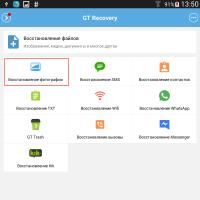 How to recover a photo on Android after deleting it?
How to recover a photo on Android after deleting it?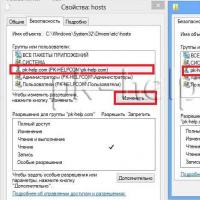 Original hosts for Windows operating systems What should be in a Windows 7 host
Original hosts for Windows operating systems What should be in a Windows 7 host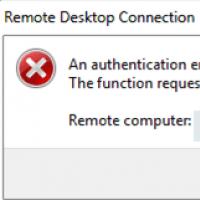 An authentication error has occurred
An authentication error has occurred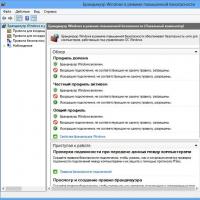 Open the following ports at the client's workstation
Open the following ports at the client's workstation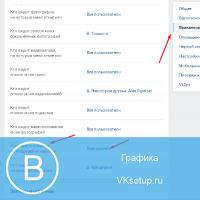 How to hide all VKontakte friends in the new version?
How to hide all VKontakte friends in the new version? Hide friends on VKontakte
Hide friends on VKontakte